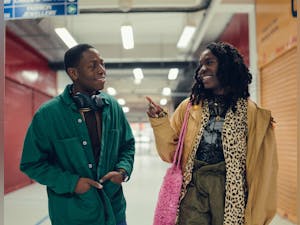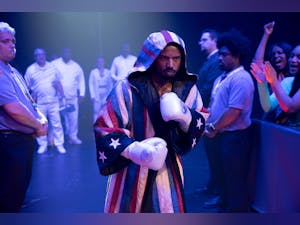From: Silver Screen
Native Cinema Showcase: 'Waikiki' explores Native self-preservation

“Waikiki,” directed by Christopher Kahunahana, is a moving drama about Kea (Danielle Zalopany), a Native Hawaiian woman attempting self-preservation while battling poverty, homelessness, abusive relationships and mental illness.
The film screened at the Native Cinema Showcase on Nov. 12. The event, presented by the National Museum of the American Indian, represented issues that resonate with many Indigenous people across the globe. As part of the event’s programming, The Eagle also talked with Kahunahana about his film.
In the opening scene, Kea is desperately trying to find new housing, and it is through this battle for security and safety that we become acquainted with her. We learn, little by little, that she has been trying to escape her boyfriend, Brandon Cruz (Jason Quinn), by living in her van instead of their shared home. The van holds all of her life’s important possessions and becomes the vehicle that moves the viewer through the plot.
Kea endeavors to procure the deposit money necessary for a new home by working as a hustler in a bar, a Waikiki dancer and an Indigenous language teacher for Native Hawaiian children. All three of these occupations hold special significance for Native issues. Her occupation in a bar exposes the pervasiveness of alcohol and unsafe working conditions specifically for Native women. Secondly, her dancing accentuates the commoditization of Indigenous culture for Western tourists.
Lastly, and most importantly, her job as a language teacher working to preserve and pass on her Native language with children is representative of the struggle Native people experience to hold onto their culture.
“People exist in multiple worlds and we often need to code shift. We speak to certain individuals in a certain way and then speak to somebody else we know in a different dialect or tone,” Kahunahana said.
This code-switching is seen within Kea’s different workplaces and is why her relationship with language is of great importance throughout the film.
Most of the dialogue is abusive, especially between Kea and her partner, Brandon. At times, Kea is also incredibly abusive to Wo (Peter Shinkoda), a fellow homeless person and her companion throughout the film. After having her car towed, being mistreated at work, and internalizing the abuse she receives from Brandon she projects her anger onto Wo both verbally and physically. Kahunahana juxtaposes these scenes of abuse with a scene of Kea in the classroom where she’s teaching her children an Indigenous phrase that roughly translates to “the land is the chief, the people are its servants.”
As this quote suggests, nature holds a special significance both within Native traditions and the film as Kahunahana interweaves scenes of water and greenery throughout the story. These scenes stand in stark contrast to the scenes of trauma that precede them. The English language acts as a corrosive and polluting force, disrupting the nature and harmony of people’s lives.
“I wanted to have people draw parallels between the destruction of nature and the displacement of Hawaiians from nature and its effect on psychology and self-image,” Kahunahana said.
As Kea’s mental state gets progressively worse during the film and we see her relive moments of the trauma, she calls upon these scenes of nature and native wisdom for peace.
As Kea’s trauma is gradually unveiled to us, increasingly time and space collapse within the film. This is signaled by a purposeful layering of sound and images that serve to make the viewer disoriented. Kahunahana does this to give the viewer a glimpse into Kea’s psyche and allow for increased identification.
The confusion and frustration the viewer experiences in discerning what is present and what is past mimics Kea’s pain, and the pain of many Indigenous communities that continue suffering from past and present trauma. “We wanted people to experience the world through Kea's eyes,” Kahunahana said.
For Kahunahana, “that’s the power of film, to give us a little glimpse of somebody else's existence.” Hence, his decision to warp reality halfway through the film allows the audience to experience time and space in the same way Kea does.
The movie ends with Kea connecting to herself, the land and her spirituality. She kneels on the grass and plunges her fingers into the dirt, symbolizing how reconnection with the land is vital for Native self-preservation.
“Kea's character journey represents the journey of Hawaii,” Kahunahana said. “And as a kānaka maoli filmmaker, I recognize that the health and healing of the people will require us to go back and reconnect with our aina, our land.”
“Waikiki” serves as a testament to the many struggles Indigenous people currently face in the wake of displacement, Western economies and pollution. It also provides a humanizing look at mental illness, in which judgment is not cast on the main character.
“Waikiki” screened during the Native Cinema Showcase on Nov. 12. This review has been updated with additional information.




